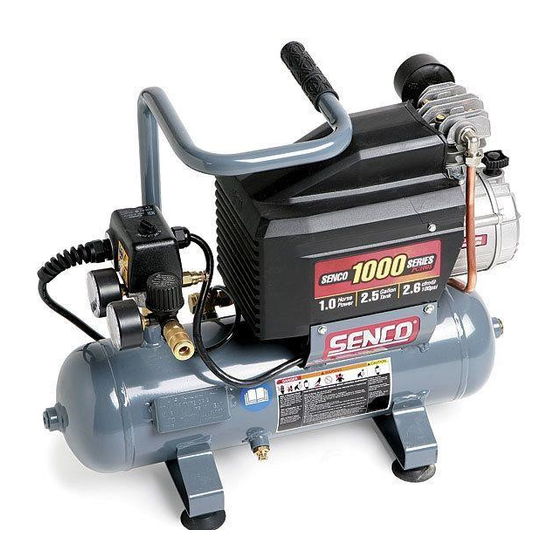Table of Contents
Advertisement
Advertisement
Table of Contents

Summary of Contents for Senco PC1005
-
Page 1: Operating Instructions
Questions? Comments? call SENCO’S toll-free Action-line: 1-888-222-8144 or, e-mail: toolprof@senco.com PC 1005 Electric Air Compressor Operating Instructions Document #FN1005 Issued 06/05/2000 Warnings for the safe use of this compressor are included in this manual. Code 197736000... -
Page 2: Table Of Contents
BURSTING ... 5 BREATHING ... 6 BURNS ... 6 FLYING OBJECTS ... 6 MOVING PARTS ... 7 NEGLIGENCE ... 7 AIR COMPRESSOR DAMAGE ... 7 COMPRESSOR FEATURES ... 8 PREPARATION ... 10 INITIAL SET-UP ... 10 LOCATION ... 10 ELECTRICAL ... 10 OPERATION ... -
Page 3: Introduction
SENCO ® Air Compressor. The contents of this manual are based on the latest product information available at the time of publication. The manufacturer reserves the right to make changes in price, color, materials equipment, specifications or models at any time without notice. -
Page 4: Safety Warnings
READ ALL SAFETY WARNINGS BEFORE USING AIR COMPRESSOR HAZARD RISK OF ELECTRIC SHOCK ELECTROCUTION SAFETY WARNINGS POTENTIAL CONSEQUENCE Serious injury or death could occur if the air compressor is not properly grounded. Your air compressor is powered by electricity and may cause electric shock or electrocution if not used properly. -
Page 5: Explosion Or Fire
If air tank develops a leak, replace the air tank immediately. Never repair, weld or make modifications to the air tank or its attachments. Use only genuine SENCO® repair parts for your air compressor. Never make adjustments to the factory set pressures. -
Page 6: Breathing
READ ALL SAFETY WARNINGS BEFORE USING AIR COMPRESSOR HAZARD RISK TO BREATHING RISK OF BURNS RISK OF FLYING OBJECTS SAFETY WARNINGS POTENTIAL CONSEQUENCE Serious injury or death could occur from inhaling compressed air. The air stream may contain carbon monoxide, toxic vapors or solid particles. -
Page 7: Moving Parts
READ ALL SAFETY WARNINGS BEFORE USING AIR COMPRESSOR HAZARD POTENTIAL CONSEQUENCE RISK FROM Risk of bodily injury from moving parts. MOVING PARTS This automatically when the pressure switch is in the “On/Auto” position. Risk of injury from negligent use. RISK FROM... -
Page 8: Compressor Features
Motor/Pressure Switch Thermal Overload / Reset Air Intake Filter Air Compressor Pump Air tank drain valve Tank Pressure Gauge Outlet Pressure Gauge Pressure Regulator Oil Dipstick 10 Oil Drain 11 Discharge Line 12 115 Volt Electric Power Cord 13 Quick Disconnect... - Page 9 “cut-out” pressure or is shut off. This allows the motor to restart freely. Moving the switch to the “Off”...
-
Page 10: Preparation
1. SENCO® DOES NOT RECOMMEND THE USE OF EXTENSION CORDS as this can create power loss and overheating of the motor. Use of an additional air hose is recommended rather than an extension cord. If use of an extension cord is unavoidable, it should be plugged into a GFCI found in circuit boxes or protected receptacles. -
Page 11: Operation
6. If you notice any unusual noise or vibration, stop the air compressor and refer to “Troubleshooting”. SHUTDOWN: 1. To stop the air compressor, move the lever on the pressure switch box to the “OFF” position. NEVER stop the air compressor by unplugging it from the power source. This could result in risk of electrocution. -
Page 12: Troubleshooting
TROUBLESHOOTING Plug cord into grounded outlet. Move switch to “AUTO” position. Turn air compressor off, wait until motor is cool, then press motor thermal overload (red) button firmly until click is heard. Replace fuse or reset circuit breaker. Check for proper fuse amperage. - Page 13 TROUBLESHOOTING REMEDY Move the motor/pressure switch to the “Off” position. If the motor doesn’t shut off, unplug the air compressor. If the electrical contacts are welded together, replace the pressure switch. Limit the air pressure to the capacity of the air compressor.
- Page 14 If lower, remove pump head and inspect valve plate, clean or replace. Clean or replace. REMEDY Clean or replace. Do not incline the air compressor more than 10° in any direction while running. Drain oil. Refill to proper level with oil. Clean. Repair.
-
Page 15: Specifications
Pump-up Time: 0-125 PSI Recovery Time: 90-125 PSI Weight Shipping Dimensions Basic LxWxH Cubic Feet PC 1005 Single 3400 Oil-splah SENCO PC 0344 Aluminium Ball Aluminium + steel sleewer Reed-Single Aluminium Canister 125 PSI 95 PSI Pressure switch 2.5 gallon 125 PSI 1 min., 35 sec. -
Page 16: Warranty
The length of this guarantee is one year from date of purchase by the original retail purchaser. During this period, Senco Products, Inc., will repair or replace at Senco’s option, any original part or parts for the original retail purchaser. This will be done free of charge, provided the parts are determined defective in materials or workmanship upon examination by a Senco Authorized Warranty Service Center, with the exceptions and exclusions described below.

















Need help?
Do you have a question about the PC1005 and is the answer not in the manual?
Questions and answers